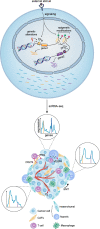Cancer cell states and emergent properties of the dynamic tumor system
- PMID: 34599005
- PMCID: PMC8494223
- DOI: 10.1101/gr.275308.121
Cancer cell states and emergent properties of the dynamic tumor system
Abstract
Phenotypic heterogeneity within malignant cells of a tumor is emerging as a key property of tumorigenesis. Recent work using single-cell transcriptomics has led to the identification of distinct cancer cell states across a range of cancer types, but their functional relevance and the advantage that they provide to the tumor as a system remain elusive. We present here a definition of cancer cell states in terms of coherently and differentially expressed gene modules and review the origins, dynamics, and impact of states on the tumor system as a whole. The spectrum of cell states taken on by a malignant population may depend on cellular lineage, epigenetic history, genetic mutations, or environmental cues, which has implications for the relative stability or plasticity of individual states. Finally, evidence has emerged that malignant cells in different states may cooperate or compete within a tumor niche, thereby providing an evolutionary advantage to the tumor through increased immune evasion, drug resistance, or invasiveness. Uncovering the mechanisms that govern the origin and dynamics of cancer cell states in tumorigenesis may shed light on how heterogeneity contributes to tumor fitness and highlight vulnerabilities that can be exploited for therapy.
© 2021 Barkley et al.; Published by Cold Spring Harbor Laboratory Press.
Figures


References
-
- Bagley RG. 2010. The tumor microenvironment. Springer Science & Business Media, New York.
Publication types
MeSH terms
Grants and funding
LinkOut - more resources
Full Text Sources
Medical
